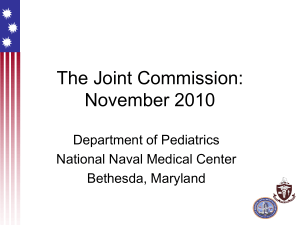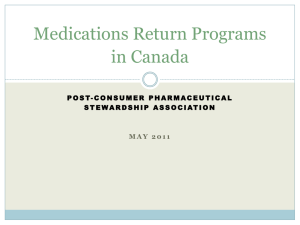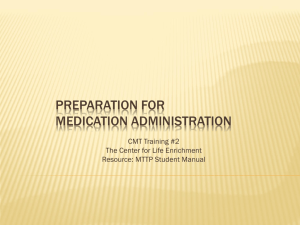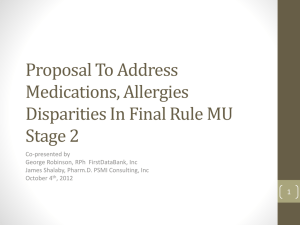Routine Medication Delivery
advertisement
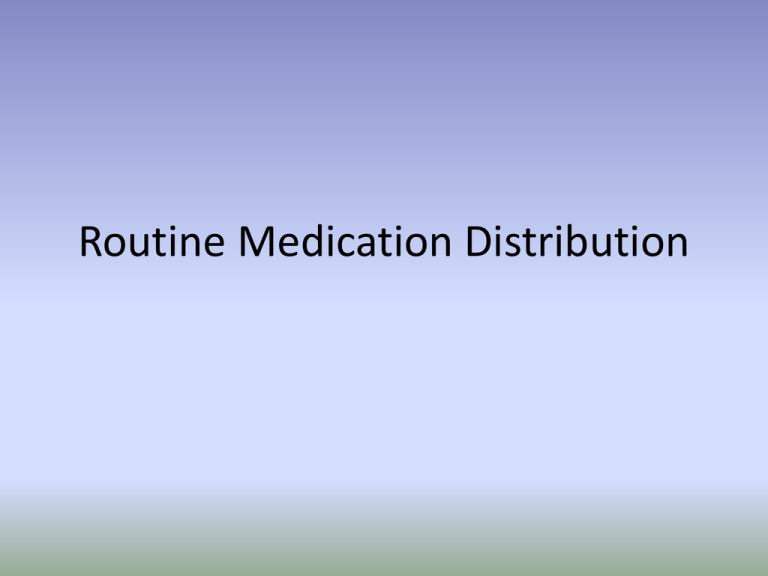
Routine Medication Distribution Routine Medication Distribution • Floor assignments are created based on number of technicians present for a given shift. – With 3 technicians, the floor breakdown will be 2/3/4/6, 7/8/9, and STAT. – With 4 technicians, the floor breakdown will be 2/3, 4/7, 6/8/9 and STAT. – With 5 technicians, the floor breakdown will be 2/3, 4/6, 7, 8/9 and STAT. • Technicians that are assigned a floor grouping are responsible for getting medications to those floors on time. – All non-STAT medications should be delivered on hourly deliveries. – All STAT medications are expected to be delivered to the care nurse within 20 minutes of print time. Routine Medication Distribution • Each technician leaves once per hour at scheduled intervals for delivery. There is a sign-out sheet in the premix room for each technician to document pick-up departure times. • Technicians take scheduled breaks at the following times: – 15 minute break between 8 and 8:30 (between 9 and 9:30 for the STAT Tech) – 30 minute lunch from 12:00 – 12:30; (12:30 – 1 PM STAT lunch) – 30 minute dinner from 18:30 – 19:00; (19:00 – 19:30: STAT dinner) Beginning-of-Shift Procedures • At the start of each shift, technicians should remain in NCP until all distribution technicians staffing for that day are present or accounted for. • Each technician should collect the cell phone and pager appropriate for his/her assigned floor grouping. Pagers can be retrieved from the Omnicell cabinet inside NCP and they need to be set to “on-page.” • Communication between technicians on first and second shift should occur to assure that any pertinent information that may continue to be relevant as one group of technicians leave and the next start is relayed appropriately. Cartfill Procedures • Each technician has an assigned floor to deliver for morning cartfill procedures, based on which floor grouping they will be covering. – – – – – The 2/3 technician takes 2nd floor cartfill. The 4/7 technician takes 7th floor cartfill. The 6/8/9 technician takes 9th floor cartfill. In the event that there is a 4/6 technician, they will take 7800. As part of this process, a census should be printed for each floor and used to determine that all patients’ medications are in the correct location and each patient bin is labeled. Along with the censue, cart labels and refrigerated medications should be picked obtained before leaving the pharmacy. • STAT technician does not participate in cartfill with the following exceptions: – STAT technicians deliver respiratory batches from SPC at the start of the day. – On Saturday and Sunday, STAT technicians are expected to deliver cartfill medications to Williams Ward (Duke South, 4th Floor). Cartfill Procedures • Upon arrival to the floor, FIRST place your refrigerated meds in the refrigerator. • Visually match patient information on the current cart label against the census report you printed in N. Central. If the no changes, you don’t need to do anything. If patient information is different, then switch out the label with the correct cart label you brought from N. Central. If you do not have a label for the current patient, make a temporary label (last name, first name and room #). You can print a permanent label when you return to N. Central. Put back your unused labels in the baskets for proper discarding. ***Note: The labels in your basket print bottom-up. So the low numbers are on the bottom if held vertically. *** • Open each patient specific bin and determine what to keep (for example, bulk medications and patient own medications) and what to remove. It is critical to check the expiration date on any medication which you won’t remove from the bin (for example, insulin vials). • Match the envelope label to the drawer label and transfer the envelope contents into the drawer. Make sure everything gets transferred. Cartfill Procedures • Technicians should visit each floor that they are assigned to and deliver medications that have not been collected from the tube station as part of morning cartfill. • Distribution technicians should visit or call the satellite pharmacy for their floors to check in with decentralized staff. • Before going to break, each technician shall check their passthrough windows in the premix room to ensure that all medications that should have been tubed during the morning have now reached the floors. “Do not tube” medications due before 9:00 should be delivered prior to break. Hourly Deliveries • Every hour, each technician is given a 15-minute window, during which they are expected to return to pick up all medications that have been filled during the previous hour. – Technicians are expected to mark the time that they leave on the sign-out sheet in premix area. – If any floors are missed from a previous run, this is marked on the other side of the sign-out sheet and it is expected that the technician then begins their delivery from the missed floor, UNLESS, the technician picked up a medication with a sooner due time than the due times on the previously missed floors. In that case, priority should be given to the medication with a sooner due time. • Medication doses in First Dose area are placed in blue bins for technician collection. • Medication doses in premix area are placed in both the passthrough windows from SPC and in grey bins. Routine Delivery Documentation Log To the right is an example of the delivery documentation log used for routine deliveries each day. Technicians are expected to be departing the pharmacy with all medications currently filled for delivery during the 15 minute window specified for each hourly delivery. Any floors that were not visited during an hourly run are also documented on this form. Hourly Deliveries • All medications should be delivered each hour. – In situations where time constraints do not allow all doses to be delivered, medications should be delivered on a priority basis. • Upon reaching the floor, the tube station should be checked at each unit for any medications that have not been collected by nursing staff. • Medications left unattended on counters should be returned to proper secured locations or returned to pharmacy if no proper identifiers are available. • If any hourly delivery is completed early, technicians can assist other pharmacy staff in any area they have received training. Placement of Medications From North Central Pharmacy • Medications taken for delivery from North Central pharmacy are placed into the patient specific bin cabinet in the Omnicell cabinet with the following exceptions: – Items that are too large for the Omnicell bins are placed on the shelf inside the locking cabinet containing the peg board. – Refrigerated items are placed in the appropriate location inside the refrigerator. – Oral Syringes with blue cap are placed in Omnicell bins unless otherwise noted by auxiliary label Oral Hazardous Medications • Oral hazardous medication batches are generally ready for pick up by the distribution staff at 17:00 each day. • The log book must be signed for each medication that is removed from the hazardous medication preparation area. • These medications are placed in patient-specific Omnicell cabinet bins, unless they require refrigeration, in which case they are placed in the blue bins inside the patient care unit refrigerators. Placement of IV Medications • IV bags requiring refrigeration should be placed in refrigerator in order by room number. – Bags should not be stacked unless they are the same order number and should be stacked by time with earliest dose on top. • • IV bags that are not refrigerated are hung from peg board according to room number and should be hung according to time with earliest dose in front. Medications syringes with yellow caps shall be placed in yellow bins inside the refrigerator unless otherwise noted. – Insulin glargine (Lantus) is an exception to this rule and is always placed in Omnicell patient specific bins. • All labeling on medication bags should be observed during delivery. – Various auxiliary labels are in use to guide technicians during delivery including: • • • • • • Do Not Refrigerate Refrigerate Short-Expiration Medications (nurse must be notified) Do Not Tube (agitation may ruin prepared medication) Incorrect placement of medications may lead to delays in patient care. See the High Alert Section of this presentation to learn about IV medications which require different storage conditions on patient care floors. Chemotherapy IV Medications • Chemotherapy medications placed in passthrough window in premix room must be signed for at the time they are collected for delivery. • Chemotherapy outer bag should not be removed at any point during delivery. • Non-refrigerated chemotherapy bags shall be placed on the shelf inside locking cabinet, NOT hung from pegs or placed in Omnicell. Respiratory Medications • All medications marked “To be Administered by a Respiratory Therapist” should be placed inside the Omnicell “Patient Specific Respiratory Medications” section. – Even if medications are marked as refrigerated, they are stored in Omnicell. • Respiratory medications that are incorrectly stored should be replaced to their correct locations upon discovery. Non-Refrigerated Medications • The following medications are never refrigerated unless otherwise marked: Generic Name Brand Name Generic Name Brand Name Acyclovir Zovirax Levetiracetam Keppra Albumin Albuminar Mannitol Mannitol Allopurinol Aloprim Melphalan Alkeran CISplatin Platinol Metronidazole Flagyl Clofarabine Clolar Micafungin Mycamine Deferoxamine Desferal MOXIfloxacin Avelox Etoposide Vepesid Nelarabine Arranon Factor VIII Recombinate OXALIplatin Eloxatin fluCYTOsine Ancoban Pentamidine Pentam 300 FUROsemide Lasix Pentostatin Nipent Ribavirin Virazole Gemcitabine Gemzar Bactrim Lacosamide Vimpat TrimethoprimSulfamethoxazole High Alert Medications • Some medications are stored in secured locations for a variety of reasons: – Lacosamide bags are placed inside the Omnicell cabinet in the SPC anteroom for pick-up and are placed into Omnicell cabinet locking drawers on floor. – Cisatracurium is placed inside pass-through windows in Premix room, but subsequently stored in Omnicell cabinets on floor. – U-500 Insulin syringes are placed inside the Omnicell cabinet in the SPC anteroom for pick-up and are locked into Omnicell cabinets on floor. – If necessary, checking the current quantity of these medications can be achieved by using the “Cycle Count” function on the Omnicell. – Other high alert medications are stored normally, per prescription and auxiliary labels. Lacosamide (High Alert) • A pink lacosamide notification will be left in pass-through window to alert distribution technician that a lacosamide dose is ready for pick-up. • Lacosamide is removed from Omnicell in SPC anteroom using the “Destock” function and selecting “Lacosamide Infusion – Any patient’s supply.” – Technician should remove both the lacosamide dose and documentation from the Omnicell cabinet and sign their name on the documentation as a record of dose delivery. The documentation is then placed into the controlled substances binder. • During delivery, lacosamide is added to Omnicell cabinet on floor using “Supplemental Restock” function and selecting “Lacosamide Infusion – Any patient’s supply.” Lacosamide (High Alert) • Because lacosamide is a controlled substance, Omnicell cabinets will ask for verification of current supply and expiration date when stocking or destocking lacosamide. • A report generates at 13:00 each day detailing which Omnicell cabinets contact expired doses of lacosamide which are to be retrieved and returned to North Central. – Returning lacosamide requires that the technician retrieve the documentation from the controlled substances binder and record that they have returned it before asking a pharmacist to take the bag to be wasted. • Lacosamide storage is typically only located on Team A or Team B of a unit, not both. – In the event that a bag of lacosamide is prepared for room 4113 and 4131, both bags would be locked in the same Omnicell cabinet as only one has a locking bin for lacosamide – If no entry for lacosamide is found in either Omnicell on a unit, contact North Central Pharmacy for assistance. Cisatracurium (High Alert) • Cisatracurium bags are placed in pass-through window inside Premix room for pick-up. – There will be documentation with the cistracurium bag, similar to chemotherapy, that requires a time and signature at the time of pick-up. • When delivering cistracurium bags, select “Supplemental Restock” and search for “Cisatracurium 200mg/100mL” bin. • As with lacosamide, cisatracurium bags are typically only stored in one Omnicell on a unit, not both. U-500 Insulin Syringes (High Alert) • When completed and ready for delivery, U-500 insulin syringes are placed in the Omnicell in the SPC anteroom and the distribution technician is notified via pager. – When destocking U-500 insulin, select “Destock” function and select “U-500 insulin – Any patient’s supply” – Unlike lacosamide, there is no paperwork required to destock U500 insulin from the Omnicell cabinet. • U-500 Insulin doses are stored differently because U-500 insulin is 5 times more potent than U-100 insulin and could cause significant patient harm if dispensed inappropriately. • When stocking U-500 insulin on the floor, select “Supplemental Restock” function, then select “U-500 insulin – Any patient’s supply.” • Like lacosamide, U-500 insulin is typically only stored in one Omnicell cabinet on a unit, not both. Discontinued Medications • Medications that are no longer in use may be placed by clinical technicians and nursing in the discontinued medication section of each Omnicell cabinet. These should be collected for return to North Central Pharmacy for discarding or recycling. • Medications marked by nursing staff to be returned to pharmacy should be collected when observed. Discontinued IV Medications Report • Discontinued medication lists are generated throughout each shift and should be observed on the subsequent delivery. – During first shift lists are available during the 8:30, 10:30 and 12:30 deliveries. – During second shift lists are available during the 15:00, 17:00, 19:00 and 22:00 deliveries. • Medications that would normally be delivered by distribution technicians should be checked for return. – Medications that are not delivered by the distribution staff, such as fentanyl, hydromorphone, etc. are not examined. – If a medication name and room number match the report, the order number should be checked to verify it is the correct item to return (changed doses may be incorrectly returned unless order number matches). • Not all items on the report will still be present for return. Returning Medications to North Central Pharmacy • Oral and topical doses returned to North Central are placed in blue return bin kept on shelving near tube station. • Refrigerated medications are returned to blue return bin inside refrigerator. • Non-hazardous oral syringes are placed in blue disposal bin inside First Dose area. • Hazardous oral syringes are placed inside blue disposal bin inside hazardous preparation area. Returning Medications to IV Room • All bags should have patient information removed or de-identified. – Labels should be removed as completely as possible from premix bags and placed in return bin next to premix room door (Zosyn, metronidazole, linezolid). – Patient name and room number should be marked through on bags prepared by SPC and placed in the appropriate return location (topshelf of refrigerator or yellow return bin under premix printer). – No medication should be returned to stock with patient information remaining on it. • Expired medications should be disposed of appropriately: – Medications with less than 24 hours until expiration are placed whole in red bin. – Electrolyte solutions (potassium chloride, TPN, magnesium, etc) can be drained into sink. The empty bag is then placed into red bin. – Expired chemotherapy and injections are not recycled and are placed whole in red bin. End-of-Shift Procedures • Ensure that all trash is removed from cart (includes personal trash as well as any leftover reports, stickers or labels). This should also be done between first and second shift as a common courtesy. • Verify that no medications are left on cart between shifts. During end-of-day cleanup, all medications should either be delivered or returned appropriately. – Check both premix and first dose areas to verify that no medication remains to be delivered. • At the end of second shift, each technician should forward their pager to 919-681-2996 (North Central Pharmacy) and return it to the Omnicell cabinet. Cell phones should be placed on charger. • Questions 1) Which high alert medications must be stored in the Omnicell when delivered to a floor location? – – – – • 2/3 floor technician STAT technician 4/7 floor technician 6/8/9 floor technician A) True B) False 4) All pagers should be rolled to their respective floor’s satellite pharmacy at the end of the day. – – • A) B) C) D) 3) Refrigerated medications are returned to a different location inside North Central Pharmacy than other medications. – – • Cisatracurium Lacosamide U-500 Insulin All of the above 2) Which distribution technician is responsible for delivering William’s Ward cartfill on the weekend? – – – – • A) B) C) D) A) True B) False 5) Chemotherapy IV medications that are not refrigerated should be hung from pegs inside wooden locking cabinet according to due time. – – A) True B) False
